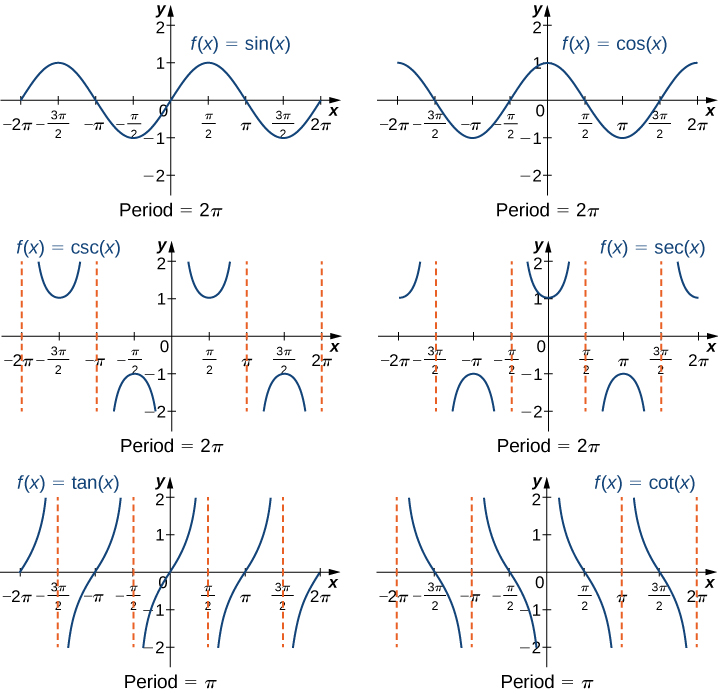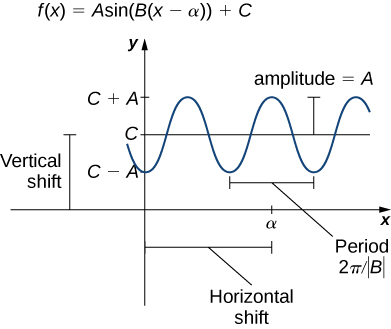Graphs and Periods of the Trigonometric Functions
We have seen that as we travel around the unit circle, the values of the trigonometric functions repeat. This repetition is evident in the functions’ graphs, showcasing their periodic nature. For any angle [latex]\theta[/latex] on the unit circle, the function values at [latex]\theta[/latex] and [latex]\theta +2\pi[/latex] are identical, since these angles correspond to the same point. Consequently, the trigonometric functions are periodic functions.
The sine, cosine, secant, and cosecant functions have a period of [latex]2\pi[/latex]. Since the tangent and cotangent functions repeat on an interval of length [latex]\pi[/latex], their period is [latex]\pi[/latex] (Figure 9).
periods of the trigonometric functions
Trigonometric functions are periodic, meaning they repeat their values over specific intervals.
Sine, cosine, and secant have a period of [latex]2\pi[/latex] radians, while tangent and cotangent have a period of [latex]\pi[/latex] radians.

Transformations to Trigonometric Graphs
Just as with algebraic functions, we can apply transformations to trigonometric functions. Transforming a trigonometric function like
In this equation, the constant [latex]A[/latex] affects the amplitude or height of the wave, [latex]B[/latex] impacts the period or width of each cycle, [latex]\alpha[/latex] controls the horizontal shift, and [latex]C[/latex] shifts the graph up or down vertically.

Breaking Down Trigonometric Transformations
- Amplitude Adjustment: Multiply the function by [latex]A[/latex] to stretch or compress it vertically. If [latex]A[/latex] is greater than [latex]1[/latex], the function stretches; if [latex]A[/latex] is between [latex]0[/latex] and [latex]1[/latex], it compresses.
- Period Modification: Multiply the input variable by [latex]B[/latex]. If [latex]B[/latex] is greater than [latex]1[/latex], the function’s period decreases, leading to more cycles in the same space. If [latex]B[/latex] is between [latex]0[/latex] and [latex]1[/latex], the period increases, and the function stretches horizontally.
- Horizontal Shift: Subtract [latex]\alpha[/latex] from the input variable to shift the graph horizontally. If [latex]\alpha[/latex] is positive, the shift is to the right; if negative, to the left.
- Vertical Shift: Add [latex]C[/latex] to the function to move the graph up or down. If [latex]C[/latex] is positive, the graph shifts upwards; if negative, it shifts downwards.
The transformations applied to the sine function can similarly be applied to the cosine function. In the general form of a cosine function [latex]f(x)=A \cos(B(x-\alpha))+C[/latex], the constants [latex]A[/latex], [latex]B[/latex], [latex]\alpha[/latex], and [latex]C[/latex] cause the same types of transformations as they do with the sine function.
Describe the relationship between the graph of [latex]f(x)=3\sin(4x)-5[/latex] and the graph of [latex]y=\sin x[/latex].
Sketch a graph of [latex]f(x)=3\sin(2(x-\frac{\pi}{4}))+1[/latex].
